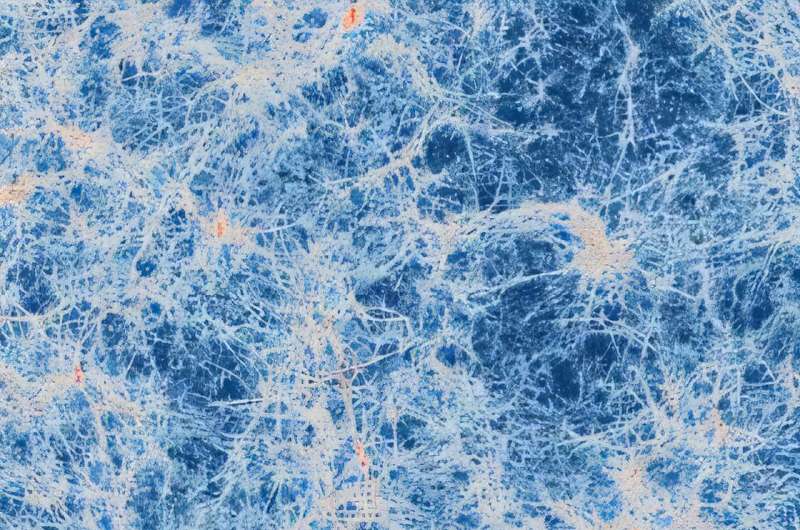Matter in intergalactic space is distributed in a vast network of interconnected filamentary structures, collectively referred to as the cosmic web. With hundreds of hours of observations, an international team of researchers has now obtained an unprecedented high-definition image of a cosmic filament inside this web, connecting two active forming galaxies—dating back to when the universe was about 2 billion years old.
A pillar of modern cosmology is the existence of dark matter, which constitutes about 85% of all matter in the universe. Under the influence of gravity, dark matter forms an intricate cosmic web composed of filaments, at whose intersections the brightest galaxies emerge. This cosmic web acts as the scaffolding on which all visible structures in the universe are built: within the filaments, gas flows to fuel star formation in galaxies. Direct observations of the fuel supply of such galaxies would advance our understanding of galaxy formation and evolution.
However, studying the gas within this cosmic web is incredibly challenging. Intergalactic gas has been detected mainly indirectly through its absorption of light from bright background sources. But the observed results do not elucidate the distribution of this gas. Even the most abundant element, hydrogen, emits only a faint glow, making it basically impossible for instruments of the previous generation to directly observe such gas.
In this new study, an international team led by researchers at the University of Milano-Bicocca and including scientists at the Max Planck Institute for Astrophysics (MPA) obtained an unprecedented high-definition image of a cosmic filament using MUSE (Multi-Unit Spectroscopic Explorer), an innovative spectrograph installed on the Very Large Telescope at the European Southern Observatory in Chile.
Even with the advanced capabilities of this sophisticated instrument, the research group had to carry out one of the most ambitious MUSE observation campaigns ever completed in a single region of the sky, acquiring data over hundreds of hours to detect the filament at high significance.

The study, led by Davide Tornotti, Ph.D. student at the University of Milano-Bicocca, used this ultrasensitive data to produce the sharpest image ever obtained of a cosmic filament spanning 3 million light-years and connecting two galaxies, each hosting an active supermassive black hole.
The discovery, recently published in Nature Astronomy opens new avenues to directly constrain gas properties within intergalactic filaments and to refine our understanding of galaxy formation and evolution.
“By capturing the faint light emitted by this filament, which traveled for just under 12 billion years to reach Earth, we were able to precisely characterize its shape, explains Tornotti. “For the first time, we could trace the boundary between the gas residing in galaxies and the material contained within the cosmic web through direct measurements.”
The researchers took advantage of supercomputer simulations of the universe run at MPA to calculate predictions of the expected filamentary emission given the current cosmological model. “When compared to the novel high-definition image of the cosmic web, we find substantial agreement between current theory and observations,” Tornotti adds.
This discovery and the encouraging agreement with supercomputer simulations are key to understanding the tenuous gas environment around galaxies and open up novel possibilities to pin down the galaxies‘ fuel supply.
Fabrizio Arrigoni Battaia, MPA staff scientist involved in the study, concludes, “We are thrilled by this direct, high-definition observation of a cosmic filament. But as people say in Bavaria: ‘Eine ist keine’—one doesn’t count. So we are gathering further data to uncover more such structures, with the ultimate goal of having a comprehensive vision of how gas is distributed and flows in the cosmic web.”
More information:
Davide Tornotti et al, High-definition imaging of a filamentary connection between a close quasar pair at z = 3, Nature Astronomy (2025). DOI: 10.1038/s41550-024-02463-w. On arXiv : DOI: 10.48550/arxiv.2406.17035
Provided by
Max Planck Institute for Astrophysics
Citation:
International team captures direct high-definition image of the ‘cosmic web’ (2025, February 5)
retrieved 5 February 2025
from https://phys.org/news/2025-02-international-team-captures-high-definition.html
This document is subject to copyright. Apart from any fair dealing for the purpose of private study or research, no
part may be reproduced without the written permission. The content is provided for information purposes only.

